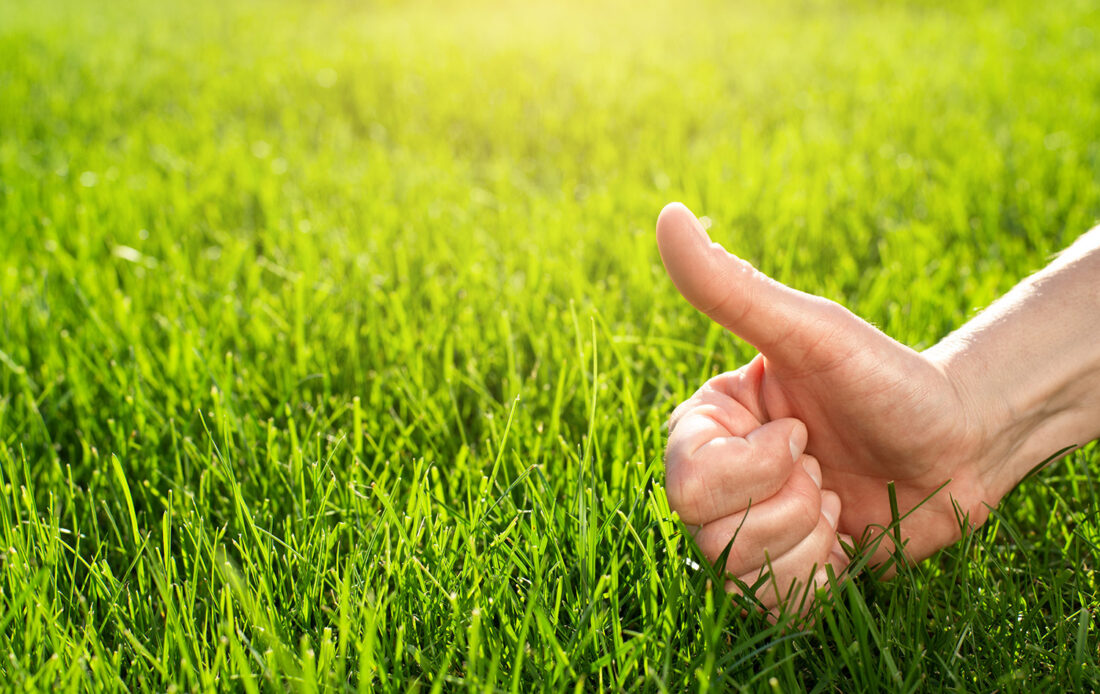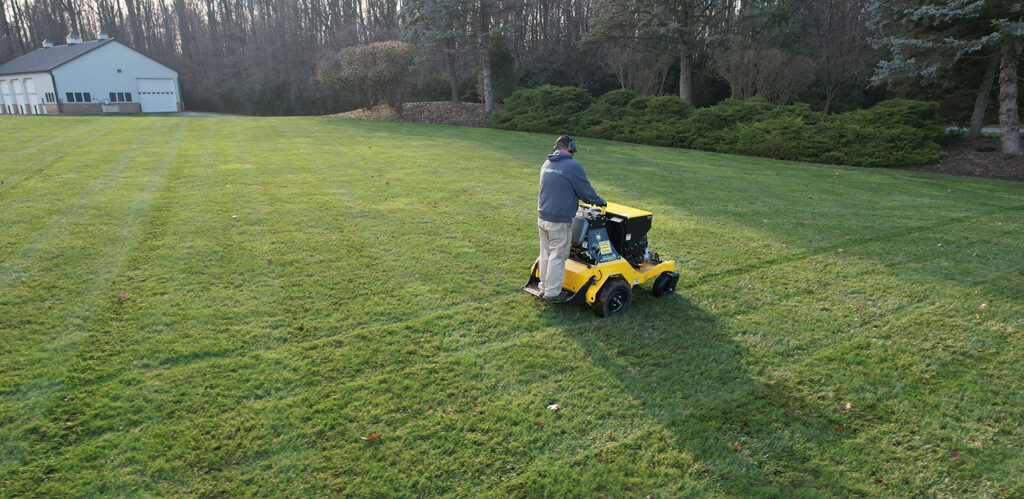
We’ve all been there, looking out over your lawn and asking yourself “what happened and why does it look so sad?” Whether it’s your own backyard, business, or athletic field, patchy grass and discoloration can seem like it happens overnight.
This is often simply due to compaction in the soil and the good news is, aeration can be a simple solution. But, aeration needs to be done correctly to make it the most effective. So, here’s tips from the lawn experts at JHL Turf Pros to help aerate and revive your lawn.
What is Lawn Aeration and How Does it Work?
Like any living thing, grass needs air, water, and essential nutrients to survive. Every great lawn starts with healthy soil. Over time, your soil can become compacted from foot traffic, heavy equipment, or natural settling.
This makes it difficult for the nutrients to permeate the soil, leaving the root system without these essentials. The result? An unhealthy lawn. Aeration solves this problem by creating small openings in the soil that allow it to breathe, enabling the root system to grow deeper and stronger as it can get the nutrients, water, and air needed to thrive.

Core Aeration vs. Spike Aeration
There are two main types of aeration:
- Core Aeration: This method involves using specialized aeration machines to remove small plugs of soil from the ground. These plugs are left on the ground to naturally break down and add organic matter back into the soil. This is the most effective way to alleviate soil compaction and improve drainage, especially in our area where there are clay soils.
- Spike Aeration: This method uses spike aerators to poke small holes into the ground without removing any soil. It can temporarily improve surface drainage, but it’s not as effective as relieving compaction since it pushes the soil aside rather than removing it.
For most turf, core aeration is the gold standard because it delivers lasting benefits for compacted soils. “In our area, clay soils are common and can get compacted really quickly. We’ve seen this cause problems in residential lawns looking patchy and discolored, business lawns that collect pools of water, and heavily used athletic fields that just can’t hold up to the wear and tear.
That’s why we highly recommend adding aeration to your lawn’s treatment plan,” said JHL Turf Pros Turf Manager, Andy Zook.
What are the Signs You Need to Have Your Grass Aerated?
There are some telltale signs your grass could use aeration services. These are the most common that we see in the Central PA-area.
- Compacted Soil: If the ground feels hard to the touch or if you struggle to push a garden stake into it, compaction is likely a problem.
- Water Pooling or Runoff: Poor water absorption is a clear sign of compacted soil.
- Thin or Patchy Grass: If you have bare spots throughout your lawn where grass is struggling to fill in, it may not be getting the nutrients it needs because of poor soil conditions.
- Excessive Thatch Buildup: Thatch—a thick layer of dead grass and organic material— may become too thick. While all lawns have some thatch, when it is over ½ inch thick, it can smother healthy grass.
- Recently Established Lawn: If you have a new construction home or business, your soil may be compacted from construction activities. Aeration helps young lawns establish deep, healthy root systems.
How to Aerate Your Lawn
Aerating your lawn might sound like a big project, but with the right tools and timing, it’s a straightforward process. Here’s a step-by-step guide to ensure you get the best results.
Consider the Timing
Timing is essential when aerating your lawn. It’s important to aerate during the active growing season to allow your lawn to recover quickly and maximize the benefits of improved airflow and nutrient access. It’s best to know what type of grass you have and when its active growing season is for optimal lawn health.
Active growing seasons vary between cool season and warm season grasses, so it’s important to know what type of grass you have to understand the optimal timing to keep a healthy lawn all year long. First, identify the type of grass you have and then determine when is the best time to aerate according to these general guidelines.
For cool season grasses like Kentucky Bluegrass or fescue, the active growing season in Central PA is in the spring or fall. Warm season grasses, such as bermuda or zoysia, have an active growing season later in spring and in the warmer months.
Prepare Your Lawn for Aeration
We recommend mowing your lawn to about 1 to 1 ½ inch tall for the best results. Watering your lawn a day or two before aeration services are performed is best if the ground has been dry.
It’s a good idea to mark any obstructions throughout your lawn. You can use flags to identify sprinkler heads, underground utilities, or other obstacles to avoid accidental damage.
Choose the Right Aeration Equipment
There are different aeration tools for different situations. For small residential lawns, you might consider renting or purchasing a plug aerator. Larger commercial properties and athletic fields require professional-grade equipment, such as aer-core aeration, to ensure even coverage and efficiency.
Even easier? Have someone else do it for you so you don’t have to rent, buy and store bulky equipment. At J.Hubler TurfPros, we use state-of-the-art aeration machines tailored to the needs of residential, commercial, and athletic turf.
How To Do the Lawn Aeration
When aerating your grass, make multiple passes over your lawn, especially in high-traffic areas. Overlapping rows helps you avoid missing sections. For larger properties, it can be helpful to work systematically by dividing the lawn into sections.

How Often Should You Aerate Your Lawn
The frequency of lawn aeration depends on several key factors, but as a general rule:
- Most Lawns: Benefit from aeration once a year.
However, to determine the best schedule for your specific lawn, consider the following:
Type of Soil
- Clay Soils: If your lawn has heavy clay soil, it can get compacted easily. This means you’ll need to aerate more often to keep the soil loose and healthy.
- Sandy or Loamy Soils: These soils don’t compact as quickly, so they require less frequent aeration.
Foot Traffic
- High Traffic Areas: Lawns that are frequently used by children, pets, or for outdoor activities tend to compact faster. More frequent aeration helps alleviate this.
- Low Traffic Areas: If your lawn doesn’t see much activity, you might not need to aerate as often.
Grass Health
- Thriving Lawns: If your grass is thick and green, aerating every couple of years might be sufficient.
- Struggling Lawns: Thin or patchy grass may benefit from annual aeration to improve root growth.
Don’t Aerate Too Often
While aeration is beneficial, doing it too frequently can stress your lawn. Over-aeration can damage grass roots and lead to other problems. It’s all about finding the right balance based on your lawn’s specific needs.
What To Do After Aeration
Now that you have aerated your lawn, it’s the perfect time to set it up for success so you can enjoy a lush and green lawn. Overseeding by spreading grass seed over thin or bare areas can help thicken the lawn while applying fertilizer to replenish nutrients can encourage growth.
After aeration is the perfect time to allow these nutrients to get down deep and reach the roots below the soil surface. Keep the soil moist by watering regularly to support recovery and new root development.
Let’s Recap
What are the essentials that you need to know when it comes to aerating your yard or field?
- Timing matters – Only aerate in the active growing season for your grass type.
- Get prepared – Mark obstructions so no unnecessary damage occurs.
- Create a system – Cover the entire lawn, especially high traffic areas.
- Nourish afterwards – Overseed and fertilize for optimal root health.
- Skip the hassle and have an expert do it for you – Want a lawn you love without the hassle? If you’re in the Central Pennsylvania area, contact J.Hubler TurfPros to get a quote, or call 717-435-3700.
Each lawn is unique and in order to get the most effective lawn care, it’s important to understand what is actually causing the issues. As part of our lawn care service plans, we offer testing and other services to ensure your lawn gets exactly what it needs, including quality aeration.
“As your neighbors, we’re always here to help. We are committed to keeping our community a beautiful, healthy place to live, work, and play,” said Andy Zook, JHL Turf Pros’ Turf Manager.
So call us at 717-435-3700 or fill out our online form to get a quote to give your lawn exactly what it’s been asking for and keep your outdoor spaces healthy and beautiful, all year long.
